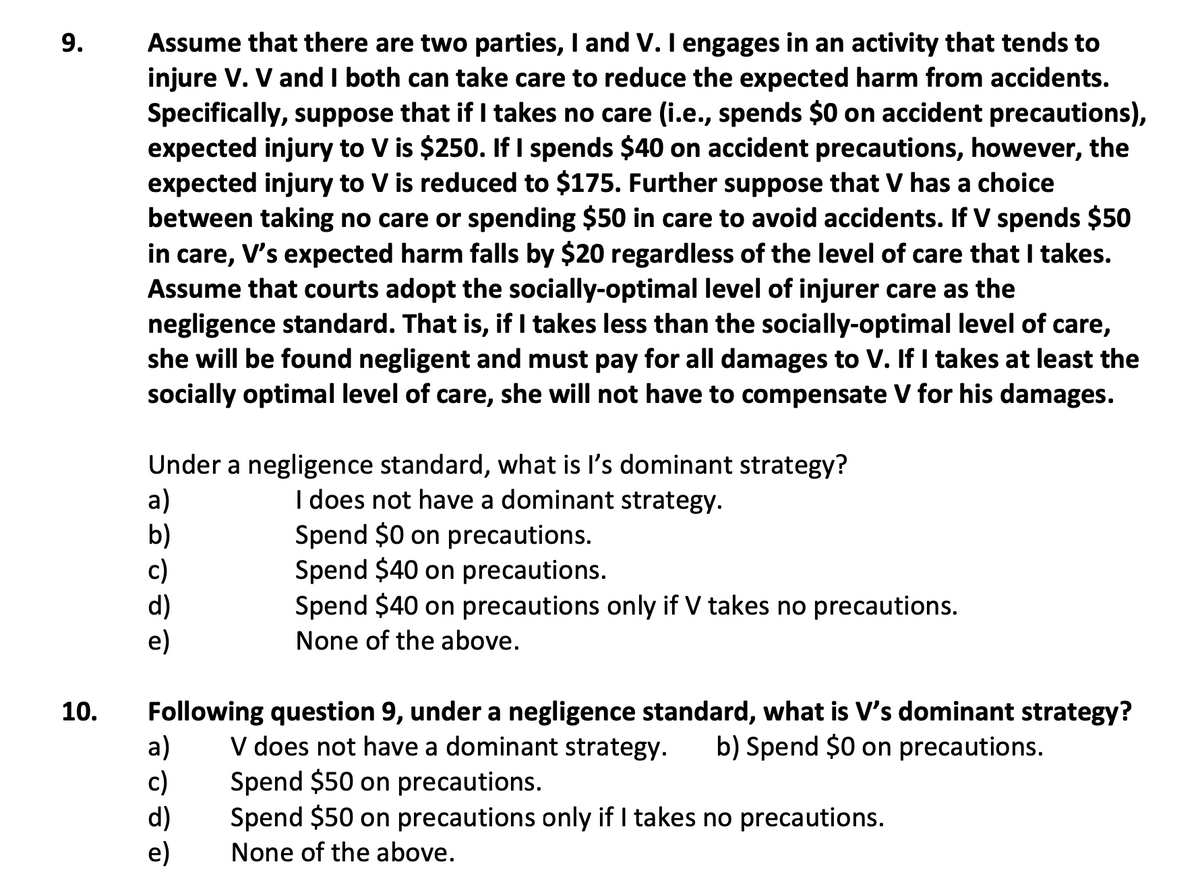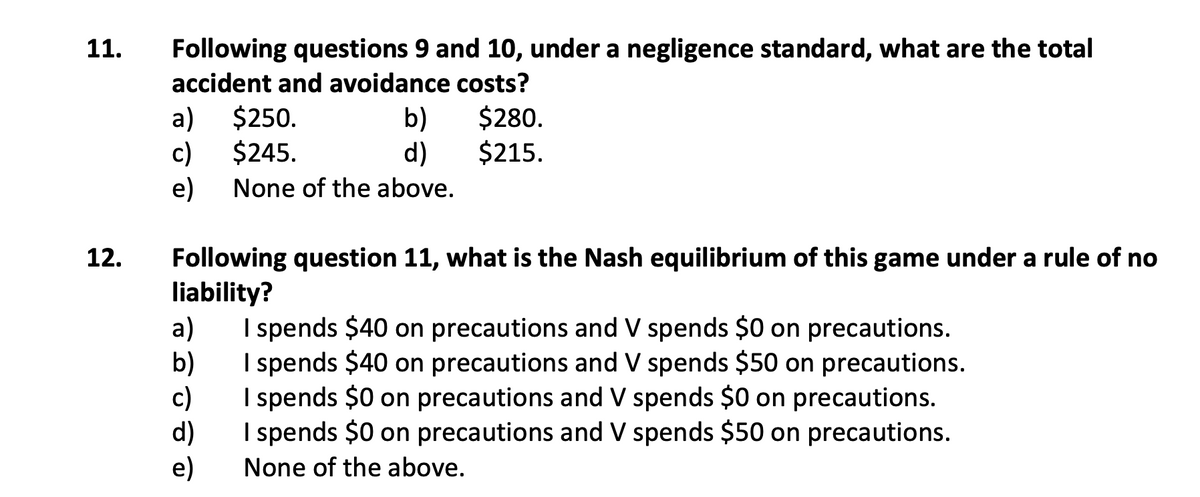Assume that there are two parties, I and V. I engages in an activity that tends to injure V. V and both can take care to reduce the expected harm from accidents. Specifically, suppose that if I takes no care (i.e., spends $0 on accident precautions), expected injury to V is $250. If I spends $40 on accident precautions, however, the expected injury to V is reduced to $175. Further suppose that V has a choice between taking no care or spending $50 in care to avoid accidents. If V spends $50 in care, V's expected harm falls by $20 regardless of the level of care that I takes. Assume that courts adopt the socially-optimal level of injurer care as the negligence standard. That is, if I takes less than the socially-optimal level of care, she will be found negligent and must pay for all damages to V. If I takes at least the socially optimal level of care, she will not have to compensate V for his damages. 9. Under a negligence standard, what is l's dominant strategy? a) b) c) d) e) I does not have a dominant strategy. Spend $0 on precautions. Spend $40 on precautions. Spend $40 on precautions only if V takes no precautions. None of the above.
Assume that there are two parties, I and V. I engages in an activity that tends to injure V. V and both can take care to reduce the expected harm from accidents. Specifically, suppose that if I takes no care (i.e., spends $0 on accident precautions), expected injury to V is $250. If I spends $40 on accident precautions, however, the expected injury to V is reduced to $175. Further suppose that V has a choice between taking no care or spending $50 in care to avoid accidents. If V spends $50 in care, V's expected harm falls by $20 regardless of the level of care that I takes. Assume that courts adopt the socially-optimal level of injurer care as the negligence standard. That is, if I takes less than the socially-optimal level of care, she will be found negligent and must pay for all damages to V. If I takes at least the socially optimal level of care, she will not have to compensate V for his damages. 9. Under a negligence standard, what is l's dominant strategy? a) b) c) d) e) I does not have a dominant strategy. Spend $0 on precautions. Spend $40 on precautions. Spend $40 on precautions only if V takes no precautions. None of the above.
Chapter7: Uncertainty
Section: Chapter Questions
Problem 7.8P
Related questions
Question

Transcribed Image Text:Assume that there are two parties, I and V.I engages in an activity that tends to
injure V. V and I both can take care to reduce the expected harm from accidents.
Specifically, suppose that if I takes no care (i.e., spends $0 on accident precautions),
expected injury to V is $250. If I spends $40 on accident precautions, however, the
expected injury to V is reduced to $175. Further suppose that V has a choice
between taking no care or spending $50 in care to avoid accidents. If V spends $50
in care, V's expected harm falls by $20 regardless of the level of care that I takes.
Assume that courts adopt the socially-optimal level of injurer care as the
negligence standard. That is, if I takes less than the socially-optimal level of care,
she will be found negligent and must pay for all damages to V. If I takes at least the
socially optimal level of care, she will not have to compensate V for his damages.
Under a negligence standard, what is l's dominant strategy?
a)
b)
c)
d)
e)
I does not have a dominant strategy.
Spend $0 on precautions.
Spend $40 on precautions.
Spend $40 on precautions only if V takes no precautions.
None of the above.
10.
Following question 9, under a negligence standard, what is V's dominant strategy?
a)
c)
d)
e)
V does not have a dominant strategy.
Spend $50 on precautions.
Spend $50 on precautions only if I takes no precautions.
b) Spend $0 on precautions.
None of the above.
9.

Transcribed Image Text:11.
Following questions 9 and 10, under a negligence standard, what are the total
accident and avoidance costs?
a)
$250.
b)
$280.
$245.
$215.
c)
e)
d)
None of the above.
12.
Following question 11, what is the Nash equilibrium of this game under a rule of no
liability?
a)
b)
c)
d)
e)
I spends $40 on precautions and V spends $0 on precautions.
I spends $40 on precautions and V spends $50 on precautions.
I spends $0 on precautions and V spends $0 on precautions.
I spends $0 on precautions and V spends $50 on precautions.
None of the above.
Expert Solution
This question has been solved!
Explore an expertly crafted, step-by-step solution for a thorough understanding of key concepts.
This is a popular solution!
Trending now
This is a popular solution!
Step by step
Solved in 3 steps

Knowledge Booster
Learn more about
Need a deep-dive on the concept behind this application? Look no further. Learn more about this topic, economics and related others by exploring similar questions and additional content below.Recommended textbooks for you

